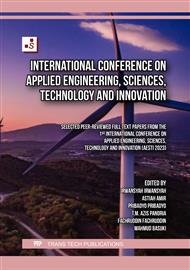[1]
Heidi Kreibich, Giuliano Di Baldassarre, Sergiy Vorogushyn, JeroenC.J.H. Aerts, Heiko Apel, Giuseppe T. Aronica, Karsten Arnbjerg-Nielsen, Laurens M. Bouwer, Philip Bubeck, Tommaso Caloiero, Do T. Chinh, Maria Cortès, Animesh K. Gain, Vincenzo Giampá, Christian Kuhlicke, Zbigniew W. Kundzewicz, Maria Carmen Llasat, Johanna Mård, Piotr Matczak, Maurizio Mazzoleni, Daniela Molinari, Nguyen V. Dung, OlgaPetrucci, Kai Schröter, Kymo Slager, Annegret H. Thieken,Philip J. Ward, and Bruno Merz (2017), Adaptation to flood risk Results of international paired floodevent studies, earth's furture jurnal, https://agupubs.onlinelibrary.wiley.com/doi/epdf/
DOI: 10.1002/2017EF000606
Google Scholar
[3]
Aprilia Findayani (2015), Kesiapsiagaan Masyarakat Dalam Penanggulangan Banjir Di Kota Semarang, Jurnal Geografi Volume 12 No 1 (106 dari 114), https://journal.unnes.ac.id/nju/index.php/JG/article/viewFile/8019/5561
DOI: 10.15294/jg.v17i2.24506
Google Scholar
[4]
Stuart N. Lane, (2017), Natural flood management, Wires WaterWiley Periodical s, Inc, Volume 4, May/ June. Natural flood management - Lane - 2017 - WIREs Water - Wiley Online Library
DOI: 10.1002/wat2.1211
Google Scholar
[5]
https://id.wikipedia.org/wiki/Pasi_Mesjid,_Meureubo,_Aceh_Barat.
Google Scholar
[6]
https://www.kompasiana.com/marianiid/5ddea7ac097f362014317f52/dampak-banjir
Google Scholar
[7]
https://aceh.tribunnews.com/2021/07/06/banjir-rendam-ratusan-rumah-di-meulaboh-ketinggian-capai-1-meter
Google Scholar
[8]
Ahmad Zikra J.P , Masimin Masimin, Eldina Fatimah. Kajian Kerugian Risiko Banjir Pada Sungai Krueng, Jurnal Arsip Rekayasa Sipil dan Perencanaan 1(2):172-182 (2018)
DOI: 10.24815/jarsp.v1i2.10966
Google Scholar
[10]
Chuang, M.-T., Chen, T.-L., & Lin, Z.-H. (2020). A review of resilient practice based upon flood vulnerability in New Taipei City, Taiwan. International Journal of Disaster Risk Reduction, 46, 101494
DOI: 10.1016/j.ijdrr.2020.101494
Google Scholar
[11]
Hessel C. Winsemius, Jeroen C. J. H. Aerts, Ludovicus P. H. van Beek, Marc F. P. Bierkens, Arno Bouwman , Brenden Jongman , Jaap C. J. Kwadijk, Willem Ligtvoet, Paul L. Lucas, Detlef P. van Vuuren, and Philip J. Ward, (2015) Global drivers of future river flood risk, Nature Climate Change
DOI: 10.1038/nclimate2893
Google Scholar
[12]
Chrisdawati Angrelia, Rendy Prihasta, Anjas Chusni Mubarok. (2020), Peranan Pemerintah Kota Tangerang Dalam Penanggulangan Dan Pencegahan Banjir Jurnal Aksi Reformasi Government Dalam Demokrasi Volume 8– Nomor 1, DOI: https://doi.org/10.34010/agregasi.v8i1.3060 Available online at: https://ojs.unikom.ac.id/index.php/agregasi
DOI: 10.34010/agregasi.v8i1.3060
Google Scholar
[13]
M.A.R. Shah, A. Rahman and S.H. Chowdhury, (2015) Challenges for achieving sustainable flood risk management, Journal Flood Risk Management
DOI: 10.1111/jfr3.12211
Google Scholar
[14]
Melillo J.M., Richmond T. & Yohe G.W. (2014) . Climate change impacts in the United States: the third National Climate Assessment. Washington, DC, USA: U.S. Global Change Research Program, https://www.nrc.gov/docs/ML1412/ML14129A233.pdf
DOI: 10.7930/j0z31wj2
Google Scholar
[15]
E.E. Koks , B. Jongman, T.G. Husby, W.J.W. Botzen (2015). Combining hazard, exposure and social vulnerability to provide lessons for flood risk management. Environmental Science & Policy, 47(), 42–52
DOI: 10.1016/j.envsci.2014.10.013
Google Scholar
[16]
Flanagan, , (1993) Identifikasi Resiko, Yogyakarta.
Google Scholar
[17]
Hudson, P., Botzen, W.J.W., Kreibich, H., (2014.) Evaluating the effectiveness of flood damage mitigation measures by the application of propensity score matching. Nat. Hazards Earth Syst. Sci. Discuss. 2, 681–723
DOI: 10.5194/nhess-14-1731-2014
Google Scholar
[18]
Kunreuther, H.C., Michel-Kerjan, E.O., (2009). At War with the Weather: Managing Large-Scale Risks in a New Era of atastrophes. MIT Press, New York, NY
DOI: 10.1016/j.ecolecon.2006.06.013
Google Scholar
[19]
Mehmet Cihan Aydin, dan Elif Sevgi Birincioğlu,2022 Flood risk analysis using gis‑based analytical hierarchy process: a case study of Bitlis Province, Applied Water Science ,12:122
DOI: 10.1007/s13201-022-01655-x
Google Scholar
[20]
Laura Tascón-González , Montserrat Ferrer-Julià ,Maurici Ruiz and Eduardo García Meléndez, (2020), Social Vulnerability Assessment for Flood Risk Analysis, Water, 12(2),558
DOI: 10.3390/w12020558
Google Scholar
[21]
Chinh Luu and Jason von Meding, (2018), A Flood Risk Assessment of Quang Nam, Vietnam Using Spatial Multicriteria Decision Analysis, Water 2018, 10, 461;
DOI: 10.3390/w10040461
Google Scholar


